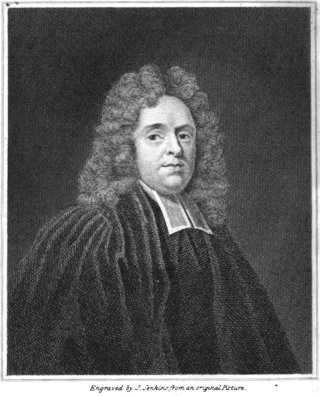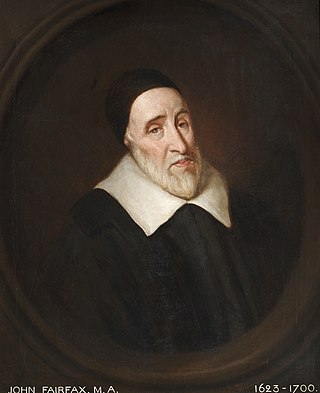Related Research Articles

William Salesbury also Salusbury was the leading Welsh scholar of the Renaissance and the principal translator of the 1567 Welsh New Testament.

Matthew Henry was a British Nonconformist minister and author who was born in Wales but spent much of his life in England. He is best known for the six-volume biblical commentary Exposition of the Old and New Testaments.
A Selection of Hymns for Public Worship is a hymn book compiled by William Gadsby, a minister of the Gospel Standard Strict Baptists in England. First published in the 19th century, it is still in current use.
John Penry, who was executed for high treason during the reign of Queen Elizabeth I, is Wales' most famous Protestant Separatist martyr.
Robert Tudur Jones, better known as R. Tudur Jones, was a Welsh nationalist and one of the country's leading theologians. His nationalistic stance, combined with Calvinist doctrine, created an integrated vision that was significant to the religious life of Christian Wales in the later half of the 20th century.

Nicholas Wotton was an English diplomat, cleric and courtier. He served as Dean of York and Royal Envoy to Charles V, Holy Roman Emperor.
John Ponet, sometimes spelled John Poynet, was an English Protestant churchman and controversial writer, the bishop of Winchester and Marian exile. He is now best known as a resistance theorist who made a sustained attack on the divine right of kings.

Casiodoro de Reina or de Reyna was a Spanish theologian who translated the Bible into Spanish.
David William Bebbington is a British historian who is a professor of history at the University of Stirling in Scotland and a distinguished visiting professor of history at Baylor University. He is a Fellow of the Royal Society of Edinburgh and the Royal Historical Society.
The Rev Dan Taylor (1738–1816) was the founder of the New Connexion of General Baptists, a revivalist offshoot from the Arminian Baptist tradition, one of two main strands within the British Baptist movement.

William Gouge (1575–1653) was an English Puritan clergyman and author. He was a minister and preacher at St Ann Blackfriars for 45 years, from 1608, and a member of the Westminster Assembly from 1643.

Tudur ap Gruffudd (1365-1405), also known as Tudor de Glendore or Tudor Glendower, was the Lord of Gwyddelwern, a junior title of the Princely house of Powys Fadog, and was the younger brother of Owain Glyndŵr, the Welsh rebel leader crowned Prince of Wales. His father was Gruffydd Fychan II, the hereditary Prince of Powys Fadog and previous Lord of Gwyddelwern. Along with his brother, Owain Glyndŵr, Tudur was a member of the Royal House of Mathrafal.

Henry Ussher was an Irish Protestant churchman, a founder of Trinity College Dublin, and Church of Ireland Archbishop of Armagh.

John Fairfax (1623–1700) was an English ejected minister.

Reginald Corbet was a distinguished lawyer in four reigns across the mid-Tudor period, and prospered throughout, although he seems to have been firmly Protestant in sympathy. He was appointed serjeant-at-law and Justice of the King's Bench, and represented Much Wenlock in the parliament of 1542 and Shrewsbury in those of 1547, October 1553 and 1555. He enjoyed great wealth, partly because his wife was an heiress of Sir Rowland Hill, the first Protestant Lord Mayor of London.
An Apologeticall Narration, Hvmbly svbmitted to the Honourable Houses of Parliament. By Tho: Goodwin, Philip Nye, Sidrach Simpson, Jer: Burroughes, William Bridge. London, Printed for Robert Dawlman, M.DC.XLIII. [1643] was a theological tract submitted by five Independent preachers to the English Parliament on 3 January 1644 as a part of the debates taking place during the Westminster Assembly.
Rose Lok was an English businesswoman and Protestant exile during the Tudor period. At the age of eighty-four, she wrote an account covering the first part of her life.

The Church of St James in Bramley, Hampshire, England was built in the Norman period and has been added to since. It is a Grade I listed building.

Alexander Denton of Hillesden in Buckinghamshire was a landowner and member of the Buckinghamshire gentry. He is best known for his two monuments, one in Hereford Cathedral the other in Hillesden Church.
John Durel (1625–1683), John Durell, or Jean Durel, was a cleric from Jersey, known for his apologetical writing on behalf of the Church of England. He became Dean of Windsor in 1677. His French translation of the 1662 Book of Common Prayer was used frequently on the Channel Islands through to the 20th century and his 1670 Latin translation had been authorized by Convocation.
References
- ↑ Jones, Robert Tudur; Dix, Kenneth; Ruston, Alan (1 January 2007). Protestant Nonconformist Texts: 1550 to 1700. Ashgate Publishing, Ltd. ISBN 9780754638643.
- ↑ Jones, Robert Tudur; Dix, Kenneth; Ruston, Alan (1 January 2007). Protestant Nonconformist Texts: 1550 to 1700. Ashgate Publishing, Ltd. ISBN 9780754638643.
- ↑ Jones, Robert Tudur; Dix, Kenneth; Ruston, Alan (1 January 2007). Protestant Nonconformist Texts: 1550 to 1700. Ashgate Publishing, Ltd. ISBN 9780754638643.
- ↑ Jones, Robert Tudur; Dix, Kenneth; Ruston, Alan (1 January 2007). Protestant Nonconformist Texts: 1550 to 1700. Ashgate Publishing, Ltd. ISBN 9780754638643.
- ↑ "Last Will and Testament of Sir Roger Martyn" (PDF). Retrieved 23 December 2016.
- ↑ Heylyn, Peter, A Help to English History: Containing a Succession of All the Kings of England, London, 1786, p.527
- ↑ "Last Will and Testament of Sir Roger Martyn" (PDF). Retrieved 23 December 2016.
- ↑ "Last Will and Testament of Sir Roger Martyn" (PDF). Retrieved 23 December 2016.
- ↑ "Last Will and Testament of Edmund Martyn" (PDF). Retrieved 23 December 2016.
- ↑ "Mary Denton, Nee Martyn, Aged 15 in 1573 Giclee Print by George Gower at Art.co.uk". art.co.uk. Retrieved 23 December 2016.
- ↑ "Last Will and Testament of Sir Roger Martyn" (PDF). Retrieved 23 December 2016.
- ↑ "The Last Will and Testament of Sir Roger Martyn" (PDF). Retrieved 23 December 2016.
- ↑ "Last Will and Testament of Sir Roger Martyn" (PDF). Retrieved 23 December 2016.
- ↑ Jones, Robert Tudur; Dix, Kenneth; Ruston, Alan (1 January 2007). Protestant Nonconformist Texts: 1550 to 1700. Ashgate Publishing, Ltd. ISBN 9780754638643.